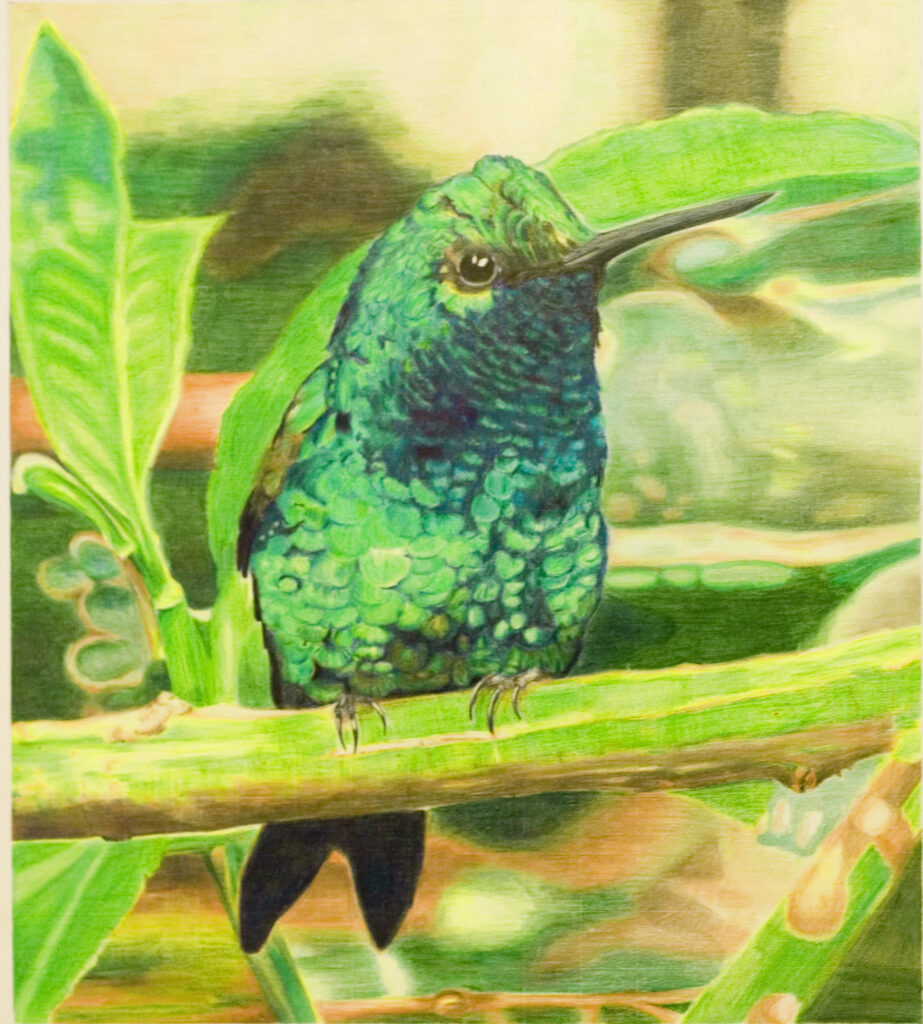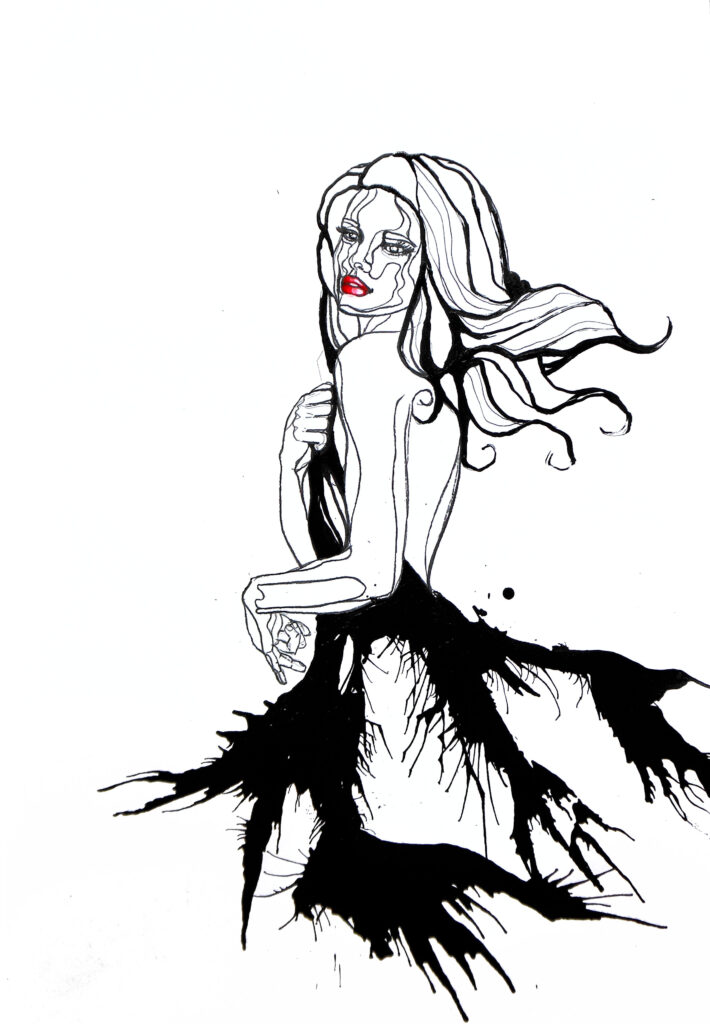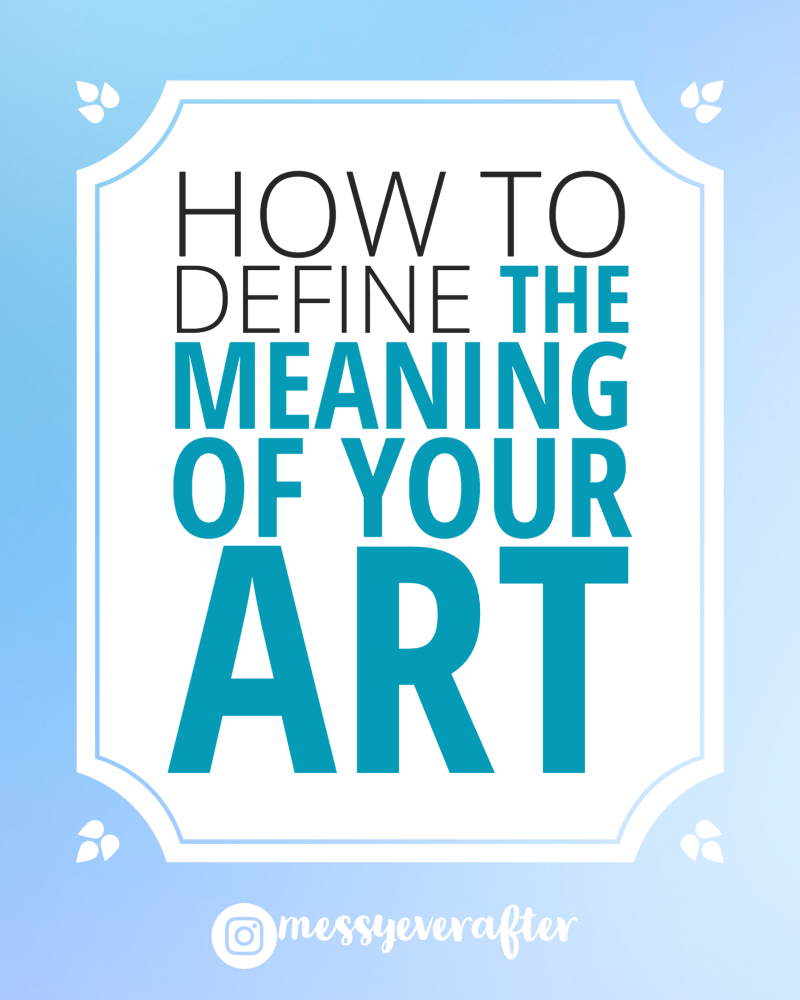Picture this:
Imagine you are at the opening of your first art show. Maybe it’s a group show. Your favorite work of art is hanging on the wall and you’re casually standing next to it while drinking a small glass of cheap box wine while trying to look super cool. Someone approaches and stares at your work.
“What does it mean?” They ask.
You try not to inhale the sip of wine you just took because you realize you hadn’t really thought about it.
Say something smart!
“Uhhhh–it’s just pretty, I guess,” you say.
Congrats, you don’t know what your art means.
I’ve been there. This is me. Hi, I’m Kelly and I feel super uncomfortable when people ask me about my art to my face. Don’t put me on the spot like that, I think. I welcome questions now, but mostly because I’ve prepared a script in my head for all of the questions I might get about my art.
Look, your art doesn’t have to have meaning. You don’t have to make art that has some grand purpose or message, but whether you are consciously aware of it or not at this moment, there is a whole world of meaning behind everything you do. You just have to connect the dots and tell a story. So, have you thought about what your art means? Are you struggling to figure it out?
It’s time to exercise a bunch of introspection and dissect the crap out of your art.
What does your art mean?
When I was working toward an art major in college, I had to sit through a lot of critique sessions. Some were helpful and many were just painful. I learned that participating in the fine art world requires a fair amount of storytelling. You are expected to tell people why your art is meaningful, which can be a huge struggle! As creators, we are too close to our work, and when we are just entering the creative world, we often have no idea how to speak the art language.
In order to figure out and define the meaning of your art, you need to ask yourself a lot of questions. The more questions you ask yourself, the clearer the meaning will become.
Time for Homework
Grab a piece of art you’ve finished and something to take notes on, and start writing down your answers to all the questions I’m going to ask below. You might find the meaning of your work after a few questions. You might need to mull them over for a while. It can take some time. Be patient. I often don’t know the meaning of my own art until I’ve finished it and can stare at it from across the room.
Also, I should say that it’s okay to get wildly creative while answering these questions. In fact, I encourage it. Don’t be afraid to lean into your inner brooding art student and explore your emotional depths. Vulnerability is your friend here. If your first thought to any question below is “I don’t know, I just like it,” you need to dig deeper. There is more hiding beneath the surface.
I mean it when I say write these answers down! Get a pen and paper and fill pages with your internal ramblings.
Questions to help define the meaning of your art:
Art supplies, color choices, composition, etcetera.
- Why did you choose your preferred medium?
- Why these colors? Why monochromatic? Why muted? Why pastel? Why saturated?
- Why did you arrange the composition like this?
- What does the symmetry or asymmetry mean to you?
- How does the composition relate to your mental process while creating? Chaos vs simplicity?
- What style trends do you see in your art? Why do you use them?
- What techniques do you use most often? Why are you drawn to them?
- Do you favor light or dark values? Why?
The subject matter, process, and you as the creator.
- What drew you to this subject?
- What emotions did you capture?
- What were you feeling when you created this?
- What does your creative process feel like?
- Where do you get your inspiration?
- How do you move your body while creating?
- Do you sit close to your work? Do you distance yourself from it? Why?
- How long do you work on a piece before taking a break?
- How long does it take you to finish a piece?
- How do you recharge your creative battery while working?
- Are you chaotic or logical while creating?
- Why do you create?
- How do you want people to feel when they look at your work?
- What do you think about while creating? What do you feel?
- What do you think or feel before and after creating?
- Who did you make this art for? You or the world? Both?
- What are you trying to say?
- Is your art catharsis or commentary? Internally or externally motivated?
How’d that go? Need a little more help?
I’m going to pull samples of my art from years ago to give examples of how to define the meaning of your work. I will give a lazy answer or an introspective answer. I definitely used the lazy answer back when I created these, but as I said before, there is more beneath the surface.
Example Meaning #1: Bird Drawing

I drew this little bird in 2009 for a college project. Here are two ways to tackle the question: what does this art mean?
Lazy answer: I like birds. They’re pretty.
Introspective answer: I wanted to explore the tedious process of photorealism and why humans yearn to recreate the beauty of nature around them. The saturated colors of this hummingbird match the verdant foliage surrounding it and you can’t help but feel uplifted while looking at it. I wanted to revel in the colors and enjoy the beauty as long as I could while filling in each square on the photorealism grid I drew.
Both answers are true, but can you see the difference? I’ll do one more.
Example Meaning #2: Ink Woman
This was drawn in 2012 when I was quite depressed. I lost my ability to draw while in such a dark place and so I started tracing magazine pictures and then applying India Ink just so I could have a finished product to look at.

Lazy Answer: Drawing this made me feel accomplished.
Introspective Answer: The darkness has a way of stealing your energy and your sense of identity. Through the simple act of tracing the contours of magazine ads, I was able to find myself within the female figures I drew without harshly judging my abilities. The black India ink represents the darkness I was trying to overcome. The way she wears it confidently was my way of projecting belief in my own resilience to control the darkness.
Boom. Look at all that meaning.
I didn’t know why I was creating this art while it was happening and I couldn’t have told you the meaning while I was in the middle of my creative process. I needed to step back and evaluate the materials I used, the head space I was in, the intention for creating, and the subjects I chose. There are no wrong answers and the meaning of your art can change over time.
Does defining the meaning of your own work seem a little easier now?
Just ask questions and see where the answers lead you.
As I said before, your art doesn’t have to have meaning, but it inherently does even if you can’t define it yet. I hope these questions have helped to get you into an introspective mindset to get you closer to the meaning of your art. If not, I’m happy to help you further (check out my consulting services).
Please leave questions and comments below while commenting is open or reach out to me directly Please leave questions and comments below while commenting is open or reach out to me directly through Instagram or email. I’d love to hear from you! Make sure to sign up for my email list below to never miss a blog post.
-Kelly
P.S. You probably know by now that I am here to help artists with these posts. If you need help with your online branding, Instagram account, or just want a creative accountability coach, then check out my consulting services. You can easily add a session to my online calendar now.


This is something I’ve been looking into and was very happy to see this in my email. You did a very great job at breaking this down and the questions you provided will be a great source for me. Thanks!!!
Yay! I’m glad it was helpful!